
Lilacs Decoded: A Deep Dive for the Cultivated Gardener
Published: 17/04/2024 | Updated: 17/04/2024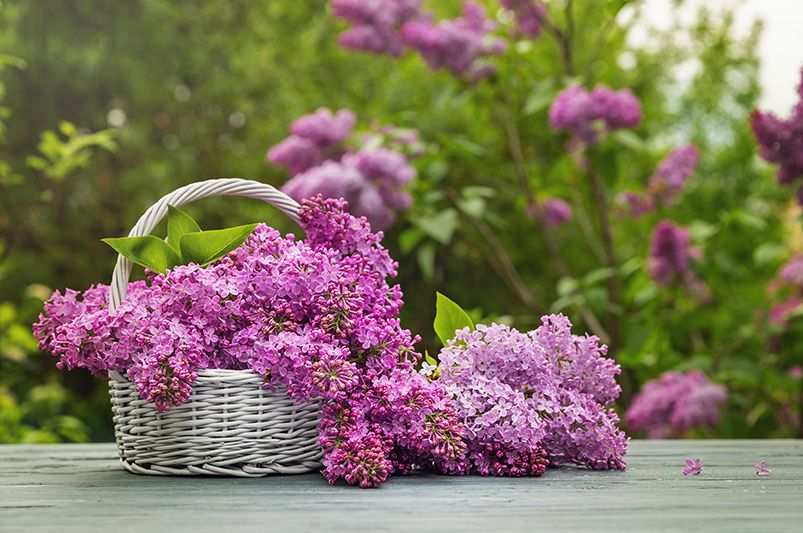
Syringa vulgaris, or common lilac bushes, are deciduous shrubs with springtime blooms. These deciduous shrubs, along with their stunning lilac tree counterparts, belong to the olive family. The delightful scents of their blossoms are what set many lilac species apart. The blooms show up in panicles or branching clusters. Only approximately 1/3 of an inch separates each blossom. The leaves are 2 to 5 inches long and range in color from gray-green to blue-green; they do not change color in the autumn. This shrub has grey to greyish-brown bark. Early autumn is the ideal time to grow lilac bushes because it doesn't freeze the ground. Their growth rate is moderate, ranging from one to two feet annually.


Caring for Lilacs
Common lilac bushes can be planted as focal points in the landscape or treated as specimen plants because of their attractiveness. In addition, they are frequently trimmed into loose hedges and planted in rows along property borders. Both the 'Miss Kim' cultivar and the dwarf shrub 'Bloomerang' lilac are tiny enough to be used in foundation plantings.
Lilacs grow readily and require little upkeep once they're established. They prefer yearly fertilization and will normally only require irrigation during protracted droughts. Additionally, pruning is typically a yearly effort.
Sunlight
Full daylight, or at least six hours of direct sunshine most days, is ideal for growing lilac shrubs. Shade is not a problem for lilacs, but too little light can prevent them from blooming. They struggle in complete shadow.
Soil
The perfect soil composition for lilac shrubs consists of a loamy texture, abundant nutrients, proper water permeability, and a neutral pH level. Even though clay soil is not ideal, lilac shrubs have the resilience to adapt.
Watering
Lilacs prefer a reasonable level of moisture in the soil. This is because lilacs thrive when the soil maintains an adequate amount of moisture. However, if the soil is too damp, it can negatively impact blooming and cause root rot. To prevent poor blooming and root rot, make sure to water young lilacs regularly, keeping the soil slightly damp. Normally, established plants only need to be watered during periods of dry weather.
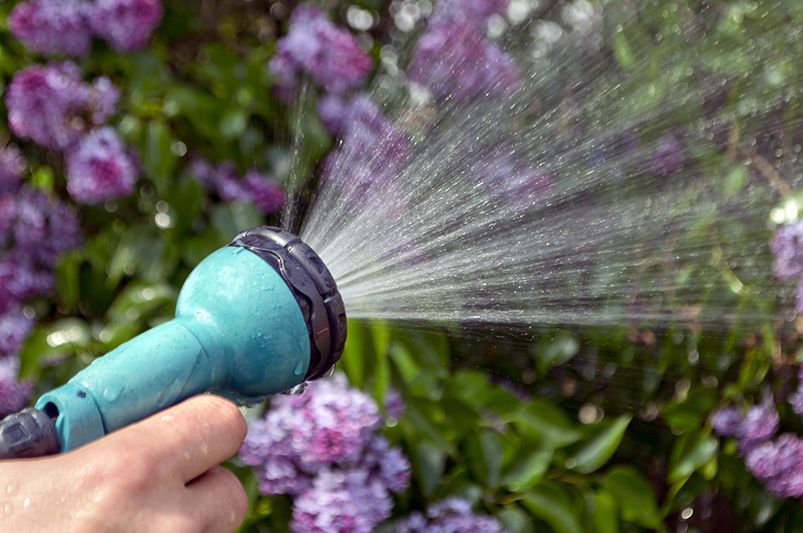
Climate and Humidity
Climates with somewhat cool summers are preferred by lilac shrubs. It is not advised to use them in warm, muggy regions like the South of the United States. Plant diseases caused by fungi can arise from high humidity levels. Lilacs can also withstand temperatures well below freezing, but they would rather be shielded from icy gusts that could shatter stems and harm flower buds.
Fertiliser Application
A spring feeding is beneficial for lilac shrubs, particularly if your soil is poor. But avoid using a high-nitrogen fertilizer as this can result in poor blooming. Instead, use a balanced fertilizer as directed on the label.
How to Prune Lilac Shrubs
Lilacs require regular pruning to ensure air circulation, which helps avoid powdery mildew and other issues, as well as to encourage flowering. Since lilacs blossom on old wood, the best time to prune is shortly after flowering is finished. Prune branches to control the shrub's height and thin down the growth for improved air circulation. Remove the oldest branches to the ground as they are no longer good sources of flowers, but don't remove more than one-third of the entire branch structure. Additionally, trim any weakened or broken branches.
Growing Lilac Plants
It is pretty easy to plant lilac bushes. Lilacs expand readily, as anyone who has raised them can attest. The majority of lilac plants grow in clumps and disperse by shoots that grow from the trunk. Additionally, these shoots can be multiplied. This is not only a cheap technique to grow a new lilac bush, but it also keeps the current lilac bush from getting too full. To give the shoot enough time to establish itself before the onset of winter weather, the optimal time to propagate is in the late spring to early summer.
Just excavate around one of the shoots and cut it off from the main plant, leaving the roots in place, to proliferate. After that, plant the shoot again in any rich soil you want, and until it becomes established, keep the soil slightly damp but not wet.
Typical Plant Diseases & Pests
Since they are hardy shrubs, lilacs can withstand most pest and disease issues. They are vulnerable to other factors, though. Powdery mildew is a fungal disease that is frequently observed on lilacs, particularly in the humid summer months. It causes the leaves to get white, powdery spots. To combat powdery mildew, there are natural remedies as well as chemical fungicides. Even though the illness normally has no fatal consequences, you should treat your lilac as soon as possible to stop the fungal spread.
Borers and scales are common pests that can harm lilac plants and cause damage to their foliage. Use neem oil or similar insecticide to treat your plant if you notice these little insects on the stems and undersides of the leaves.
How to Encourage Flowers
Although the precise date of flowering season could vary depending on the type, lilacs bloom in the middle to late spring mostly. The smell of the little, four-lobed blossoms is incredibly pleasant and is released in conical clusters. Although the blooms are short-lived, a healthy plant should easily rebloom each year. It's not required to deadhead or remove the wasted blooms. Consider planting several lilac kinds that flower at different times so you may enjoy a longer blooming period.
Poor lilac flowering is frequently caused by a lack of sunshine. Keep an eye on your lilac for the entire day to make sure it isn't spending any significant time in the shadow. Somewhat damp soil also promotes a more robust bloom. Mulch surrounding the bush will help keep the soil moist and keep weeds out of the way that could compete with the lilac.
Typical Issues With Lilacs
Shrub lilacs are usually not troublesome plants for the garden. However, they may run into a few typical problems.
Inadequate Blooming
A revitalization pruning may be necessary for a lilac that isn't flowering as much as it once did. To achieve this, as soon as the bloom season ends, cut off one-third of the oldest branches. After flowering, cut off half of the remaining old branches in the following growth season. And cut off the remaining old branches in the following year. In a few years, new, more furiously flowering branches will take their place.
Browning Leaves
Many things could be causing lilac leaves to turn brown. Browning of the leaves can be caused by insufficient watering, especially in young plants. Excessive fertilizer application and extended exposure to intense sunshine can also harm foliage. The most common cause of dark blotches on leaves, however, is bacterial blight. This infection usually arises from poor lilac growing conditions. Therefore, one of the greatest ways to treat the illness is to rectify its conditions. Additionally, remove diseased foliage as soon as possible to stop the illness from spreading.
Floral Faves: Must-Have Lilac Varieties for Every Garden
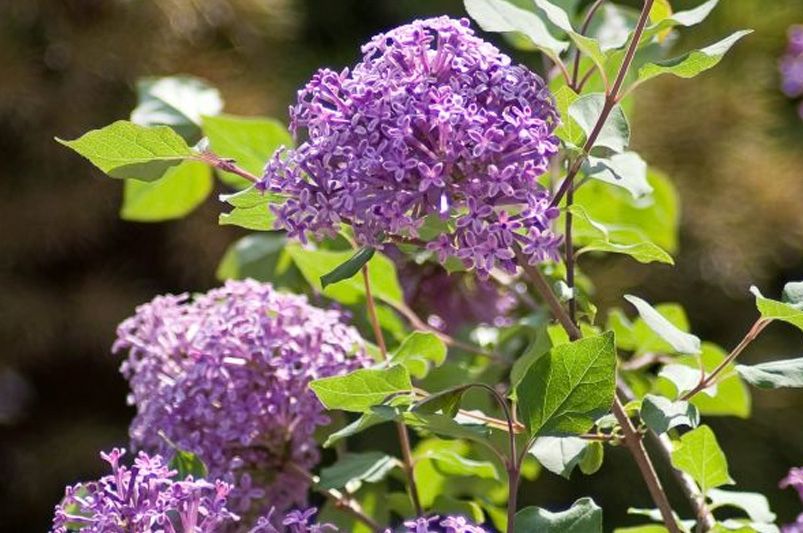
Bloomerang Dark Purple Lilac
Get Bloomerang lilacs to enjoy months of flowers rather than just weeks, and don't settle for lilacs that bloom only once a year. The original reblooming lilac is called Boomerang Purple. Like other lilacs, it blooms in the spring, stops briefly to allow new foliage to sprout, and then resumes blooming in the middle of summer and into the autumn.
Bloomerang is a bit smaller than other lilacs, reaching a height of only 4 to 6 feet, though it still has a lovely, rounded shape that complements any environment. Star-shaped flowers have a lovely aroma and are a lovely shade of traditional light purple.
Outstanding disease resistance is another feature of Bloomerang lilacs; you don't have to worry about their unsightly brown or white leaves detracting from the blooming display. Additionally, it is resistant to deer and loves the sun, just like other lilacs, making it a carefree option for a lifetime of beauty.
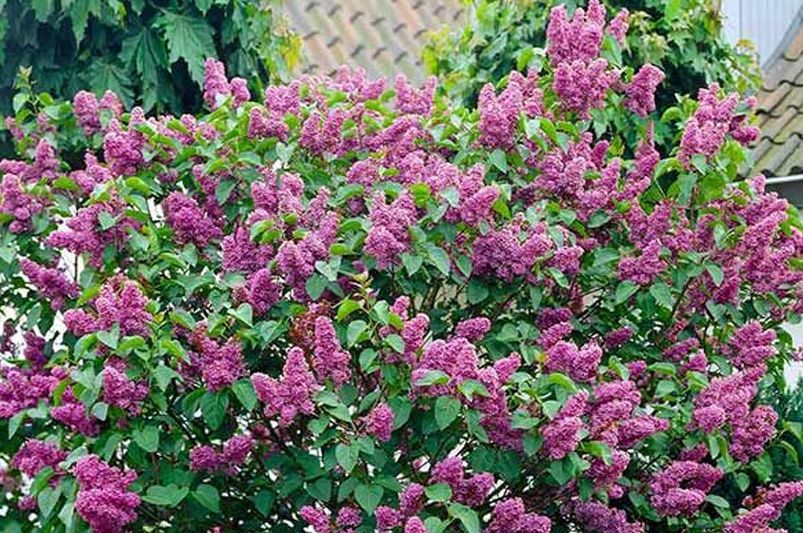
Common Purple Lilac
The aroma of fragrant blooms in the springtime! There's nothing like the alluring smell of a fresh lilac in bloom. Lilac blossoms are harvested for their oil, which is then utilized in lotions and perfumes. Contemporary businesses attempt to replicate the appealing aroma of candles and air fresheners, but they can never surpass the authentic version. Having your very own lilac shrub to greet spring every year is just so nice.
One of the nicest lilac bushes is the Common Purple Lilac (Syringa vulgaris); in fact, most other lilac varieties are derived from the Common Lilac! Introduced from Europe in the eighteenth century, it underwent intensive breeding to produce numerous novel varieties that are being cultivated to this day.
Large and abundant, the pleasantly fragrant flowers offer fantastic springtime color. They make stunning cut flower bouquets and look spectacular in the environment. With this plant, happy memories will be made.
In mid-spring, lovely clusters of lavender flowers bloom from the tips of the branches. They create a striking contrast with the heart-shaped, dark green foliage. These plants, which are cold tolerant in USDA hardiness zones 3 through 7, consistently bloom in chilly weather. Because they are so simple to grow, this huge, freewheeling woody shrub has been a favorite for many years. Given its hardiness, it can survive extremely harsh winters with temperatures as low as -40 degrees! There have been discoveries of hundreds-year-old farmsteads surrounded by ancient lilacs.
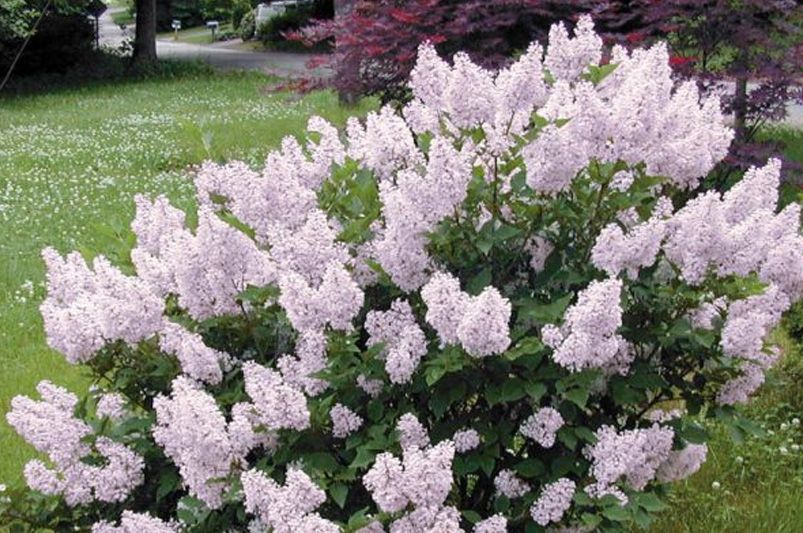
Miss Kim Lilac
A deciduous blooming shrub, the 'Miss Kim' lilac blooms in clusters of highly fragrant lavender-purple panicle-shaped blossoms in the spring. In contrast to the classic common or French lilac (Syringa vulgaris), it has smaller blooms, a shorter maturity height, and a different flower scent. It also exhibits greater resistance to powdery mildew. 'Miss Kim' blooms later than other varieties, therefore frost damage to its flower buds is less likely.
In comparison to other lilacs, the 'Miss Kim' cultivar is regarded as a dwarf plant; nonetheless, the compact would be a more accurate descriptor. Compared to regular lilacs, "Miss Kim" is a full-sized bush that is denser and less lanky. Additionally, 'Miss Kim' will begin to bloom earlier than a typical lilac when it is first planted.
Typically, this lilac is planted in the spring or autumn as a potted nursery specimen. Miss Kim is a shrub that grows fairly slowly; it will take it three years or longer to reach its maturity height of six to eight feet.
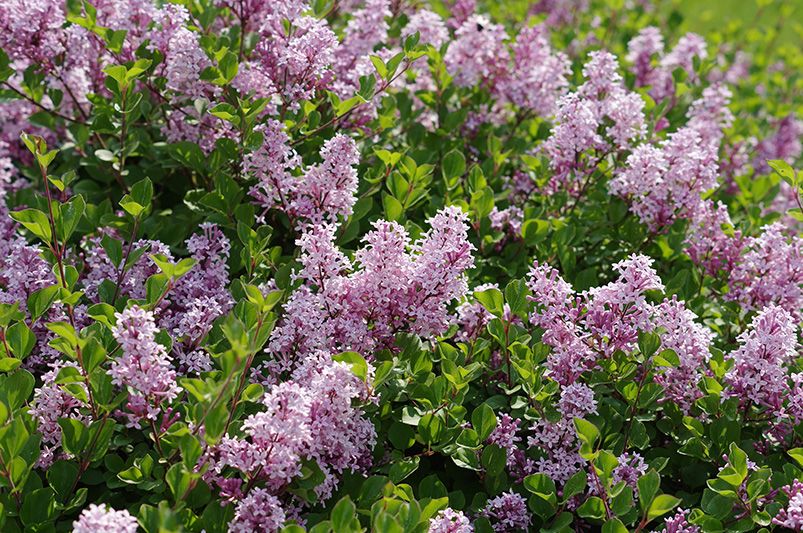
Dwarf Korean Lilac
With its perfectly rounded bloom head and delicate green foliage, Dwarf Korean lilacs make the ideal standard plant. They are planted on bare 50cm stems. Dwarf Korean lilacs produce an abundance of fragrant, mauve-pink blossoms in late spring that waft through the air.
This well-trained standard adds a beautiful architectural focal point when it is used to decorate doorways and entrances. Lilac standards can be planted directly into the borders of a cottage garden or grown in attractive terracotta pots. This adorable dwarf lilac reaches a maximum height of 4.9' or 1.5 meters and a spread of 60 cm (24").
It grows easily in full sun on average, well-drained, dry to medium moisture soil. Tolerates mild shade well and comes to full bloom in full sun conditions. Typically, it prefers wet, slightly acidic to slightly alkaline soils that are rich in organic matter with plenty of ventilation.
Generally, this plant has a good tolerance for urban conditions. If faded flower panicles are promptly removed before the seed sets, the next year's bloom will be more abundant so aim to prune it as early as possible for the best results.
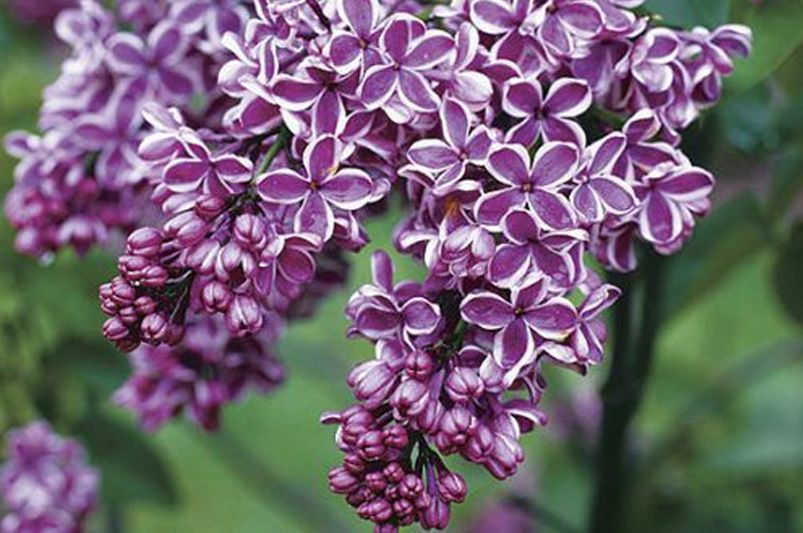
Sensation Lilac
Gorgeous pin-striped flowers! Choose Syringa vulgaris 'Sensation' for your Sensation Lilac to add some pop to your spring garden. While lilacs in general are lovely, this particular kind truly elevates the experience.
In a lilac flower, there are hundreds of tiny florets. In spring, the florets gather into enormous, fragrant panicles that emerge from the branches. The entire bush develops a profusion of sensation trusses. If you look closely, you'll see something rather magical. Every reddish-purple flower petal has a thin white border that makes it stand out.
In cut flower arrangements, the lilac flowers are resilient and long-lasting. Bring plenty of that lovely spring enchantment inside. This superb shrub is a remarkable option that leaves a lasting impression on everyone who comes into contact with it. It will attract butterflies, hummingbirds, and other helpful pollinators who frequent your yard in the spring and will also benefit from Sensation Lilac.
Enrich Your Garden with Lilacs: A Classic Choice
Lilacs stand out as a timeless addition to any garden. Their simple elegance, delightful scents, and low maintenance make them a favorite among gardeners. Whether you prefer the classic charm of the Common Purple Lilac or the understated beauty of the Bloomerang Dark Purple Lilac, there's a lilac variety to suit every taste. With their adaptability and ability to attract pollinators, they bring both beauty and ecological value to outdoor spaces. Consider adding lilacs to your garden and enjoy their subtle yet enduring presence for years to come. And for personalized advice and guidance, don't hesitate to reach out to the experts at ShrubHub.


